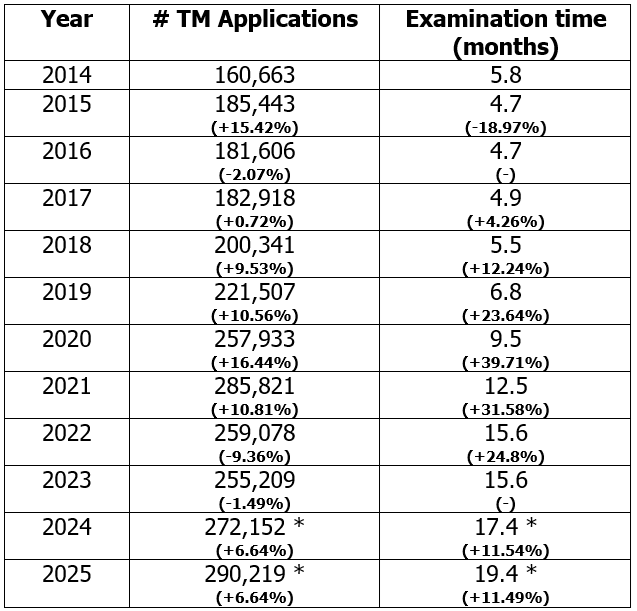Practice Notes Tackling the increasing delay in Korean trademark examination
As anyone with recent experience of filing trademarks in Korea will already be painfully aware, the examination timeframe has been increasing significantly.
In a recent paper published by the Korean Intellectual Property Office (KIPO) and Korea Institute of Intellectual Property (KIIP) (“상표심사처리기간 지연의 경제적 피해액 추정”, August 2024), this topic is discussed in relation to the economic impact caused by trademark examination delays. The majority of data in this article is taken from said paper.
For business owners, delays in achieving trademark registration can have severe implications. With Korea being a first-to-file jurisdiction with rights largely based on registered trademarks, there is an inherent risk in using a trademark prior to registration. However, delaying product launches while waiting for examination results leads to lost potential sale opportunities, and if a trademark has to be changed due to a conflict this can also result in costs wasted on product development, marketing etc.
Aside from these direct impacts, there are also knock-on effects such as job losses and reduced production while companies delay launching projects, as well as a more general reluctance to innovate and invest in new ventures due to brand uncertainty.
▒ Causes for the increasing delay
The annual number of trademark applications filed and average examination time (i.e. time between filing and examination result) over the last decade is shown in the below table, with the year-on-year percentage difference in brackets:

(* Figures for 2024/2025 are estimates)
While the number of trademark applications has steadily grown, the increase in examination time is disproportionate. Comparing the 2014 figures with estimated 2024 figures, the number of applications is expected to increase by 69.39% over the 10-year period, while the examination speed is projected to be 200% slower.
The increasing delay is primarily attributable to two factors:
(1) Lack of manpower
The increase in the number of trademark applications was not matched by a corresponding increase in examiners, resulting in a larger caseload per examiner and bottlenecks in examination.
The number of trademark examiners increased from 146 in 2019 (~1,500 cases per examiner), to 149 in 2021 (~1,900 cases per examiner), to 175 in 2024 (~1,550 cases per examiner). (Source: Seoul Economic Daily)
While the number of examiners has increased, there is still a significant backlog of cases awaiting examination.
(2) Increase in requests for accelerated examination
A surge in accelerated examination requests diverted resources from general examination. The number of requests grew astronomically from 6,186 in 2018 to 46,744 in 2023 — a more than seven-fold increase over a five-year period.
This is mainly attributable to requests for accelerated examination being accepted based on a senior trademark search report prepared by a KIPO-designated agency starting from July 2019. This greatly reduced the burden in requesting accelerated examination and made it easier for applicants to get their applications examined quickly, even if they had no clear intention to start using the mark.
▒ What can be done?
The paper proposes a number of measures aimed at improving the situation:
(1) Increasing the number of examiners
(2) Utilizing AI to strengthen pre-examination
This could include easing examiner burden by implementing an AI-powered similar trademark search engine for use during examination, and improving applicant confidence by developing a pre-filing screening tool that can estimate the chances of a trademark achieving registration.
(3) Improving applicant communication
This includes increasing awareness of the designated goods/services list that is updated annually (applications only covering pre-approved goods/services are afforded lower official fees and are not likely to be refused based on vague/broad descriptions or misclassification), and alerting applicants of the estimated timeframe for examination.
(4) Restricting accelerated examination
In response to the surge in requests, KIPO has already stopped accepting accelerated examination requests based on trademark search reports as of January 2024. In order to request accelerated examination, applicants must now rely on other grounds such as (i) they are already using the mark or have evidence showing imminent use is planned; (ii) another party is already using the mark for identical/similar goods; (iii) the applicant received a warning letter concerning their application from another party with senior rights, etc.
(5) Shortening the opposition period
Even if an application passes examination (i.e. the examiner finds no grounds to provisionally refuse the application), it is still subject to a two-month “publication period” during which any party can file an opposition with the intention of preventing the application from achieving registration. It has been suggested that this period be reduced to 30 days, which would allow non-opposed applications to be registered faster. (In return, opponents may be afforded longer time extensions for preparing their opposition.)
▒ Final thoughts
As discussed, increasing delays in trademark examination can have significant economic impacts, hindering business growth and innovation. With KIPO intimately aware of this situation, we are hopeful that changes will be forthcoming to improve efficiency and bring about a return to a more predictable and business-friendly trademark examination system.
Written by Jonathan MASTERS